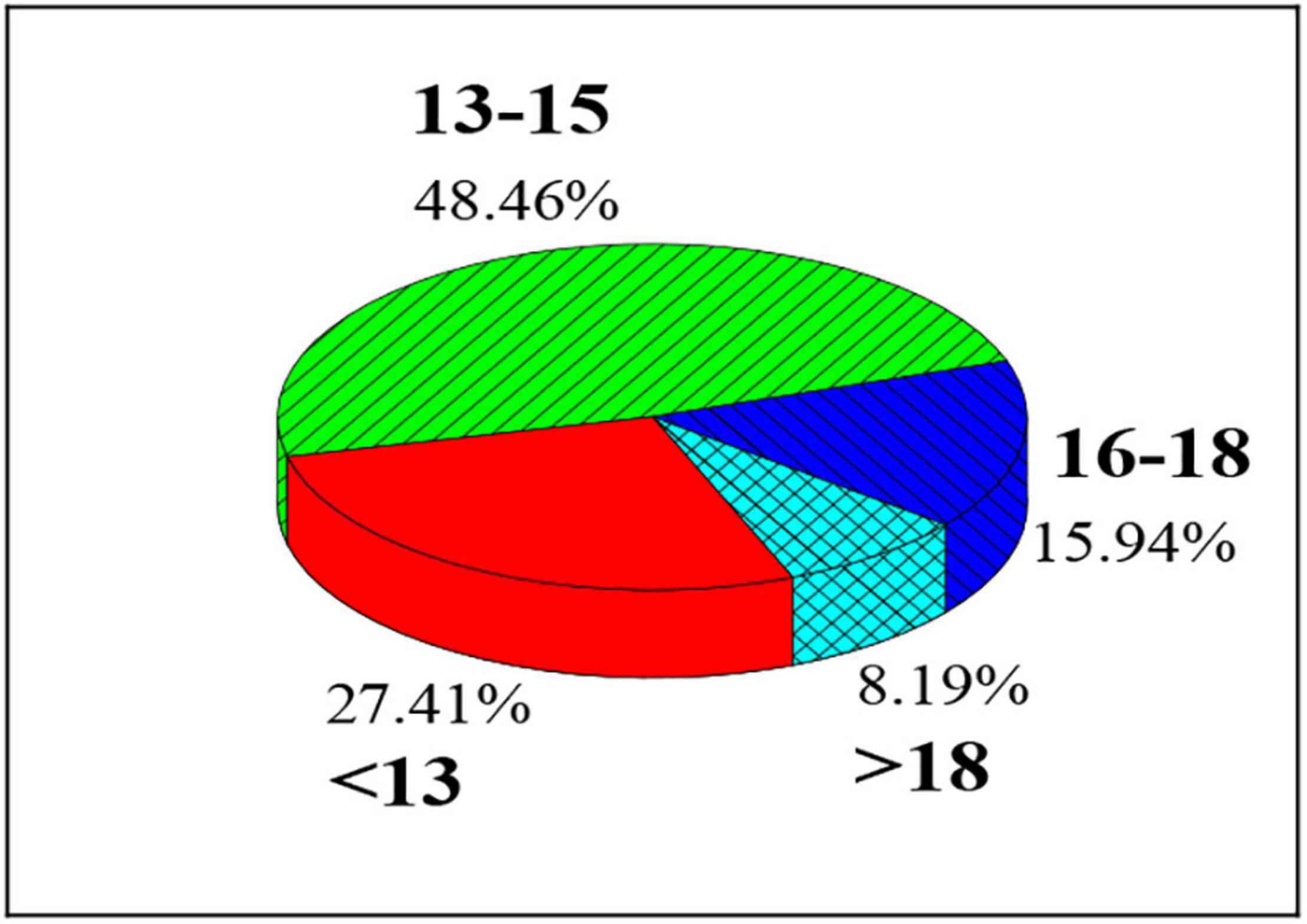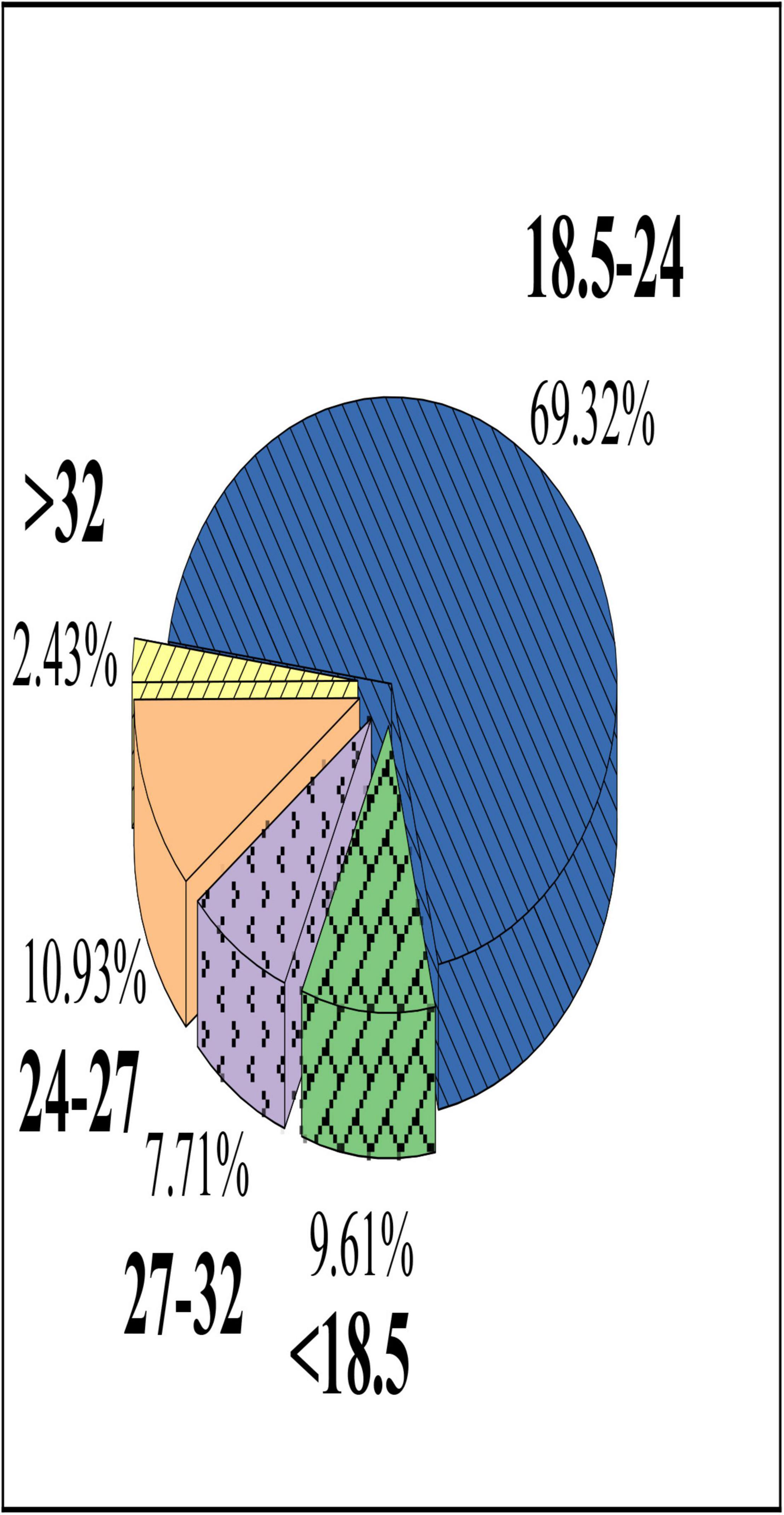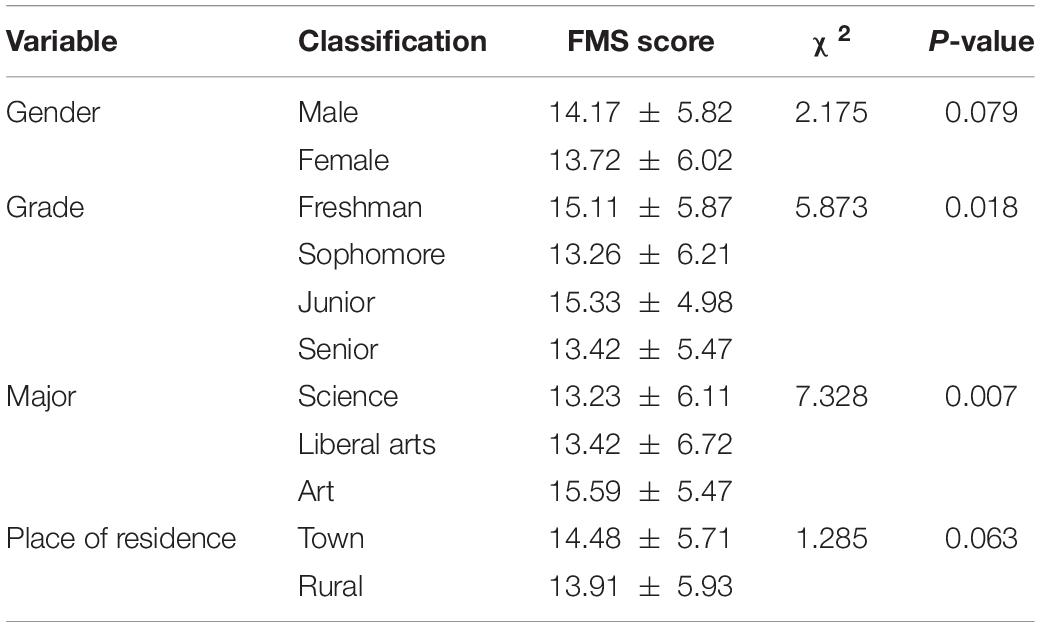- 1College of Sports Science, Tianjin Normal University, Tianjin, China
- 2Department of Kinesiology, The University of Texas at San Antonio, San Antonio, TX, United States
College students have taken part in less and less physical activities as a result of the common static lifestyle in recent years, lowering the level of motor function. This phenomenon has been a source of concern for schools and the government, and it is necessary to take corresponding measures to change it. The general motor function level of Chinese college students is explored first based on artificial intelligence and the human–computer interaction technology. The Physical Activity Questionnaire for College Students is compiled by referring to the International Physical Activity Questionnaire, and 561 students from colleges in Tianjin province are assessed based on the functional movement screen (FMS). Spearman correlation and multivariate regression analysis (MRA) are used to analyze the correlation between the motor function and physical activity status. In terms of lunch break frequency, the proportion of students having one to two lunch breaks in a week is the highest (54.15%); in terms of the frequency of doing moderate physical exercise, the proportion of students doing moderate physical exercise for 1–2 days in a week is the highest (50.61%); in terms of the frequency of doing heavy physical exercise, the proportion of students doing heavy exercise for 1–2 days in a week is the highest (47.26%); in terms of the sedentary time, the proportion of students with sedentary time more than 5 h in a day is the highest (40.61%); in terms of eye use time, the proportion of students with 8–10 h eye use time in a day is the highest (43.61%). Besides, in terms of the FMS score, the proportion of students with 13–15 FMS is the highest (48.46%). The hurdle step (21.03%), straight knee lift (22.52%), and body rotation stability (18.31%) have a relatively low proportion among the three-point items. There is a positive correlation between motor function score with the time of moderate exercise and the time of heavy exercise (P < 0.05). College students generally have insufficient rest time, long eye use time, and long sitting time, leading to a low level of motor function, manifested by an asymmetry between both sides of the body and poor trunk stability. It is recommended to add hurdling steps, straight knee lifts, and body rotation stability tests to college physical education courses.
Introduction
The decline in the physical quality of college students in China has become a matter of general concern. According to the data of the National Student Physical and Health Survey, it is evident that the explosiveness, strength, and endurance of college students aged 18–22 have been slowly declining in recent years (Ghrouz et al., 2019; Penglee et al., 2019; Graupensperger et al., 2020). Scholars generally believe that it is due to the weak physical fitness awareness and the unhealthy lifestyle, that is, the static lifestyle leads to insufficient physical exercise (Kim and Cardinal, 2019; Wilson O. W. et al., 2019). Therefore, how to make students actively participate in physical exercise has become a problem faced by many colleges and universities (Goh et al., 2019). Related research shows that insufficient physical exercise is the first independent risk factor for the occurrence of chronic non-infectious diseases, and its mortality is second only to high blood pressure, smoking, and high blood sugar (Holland et al., 2019; Huberty et al., 2019). The human motor function is regulated by the close coordination of the pyramidal system, the basal nucleus, and the cerebellum, which are functionally inseparable as a whole. When the motor function is impaired, there are function disorders manifested as muscle strength and sensory and cerebellar function out of control (Acebes-Sánchez et al., 2019). Brandwayn et al. (2020) conducted a questionnaire survey on the quality of life of 18–21-year-old college students and assessed their physical fitness. The results found that regular physical exercise affected their personal health through all the following indexes: the functional reserve of the organism, the maneuverability and adaptability of the body, the lifestyle, and the resistance of the organism. Fletcher (2016) found that only 20–40% of college students engaged in a recommended amount of physical exercise. In addition, the motivation of doing physical exercise is greatly affected by friends, family, and social pressure, and they are usually motivated by external factors to do sports rather than autonomous motivation.
Human–computer interaction refers to the response of a system to a user, during which information is exchanged between humans and computers (Yıldız, 2019). Artificial intelligence is a branch of computer science involving robots, language recognition, image recognition, natural language processing, and expert systems (Fritz et al., 2020). The combination of artificial intelligence and human–computer interaction is called interactive artificial intelligence. Educational psychology is the study of human learning, the effects of educational interventions, teaching psychology, and social psychology in education (Robert et al., 2020). When it is applied to physical education, it can analyze the sports characteristics of students combining sports knowledge, sports wisdom, and sports theory, promote college students to actively participate in physical activities, and change the existing static state lifestyle, manifested by indulging in watching TV, surfing the Internet, and sitting for a long time (Klug et al., 2020; Zheng and Liu, 2020).
In the study, the Physical Activity Questionnaire for College Students based on the artificial intelligence and human–computer interaction is compiled by referring to the International Physical Activity Questionnaire, and the physical fitness of college students is assessed based on the functional movement screen (FMS). Through analysis of the current physical exercise status (number of lunch breaks in 1 week, days of moderate exercise in a week, days of heavy exercise in a week, class time in a day, sedentary time in a day, sleep time in a day, moderate exercise time in a day, heavy exercise time in a day, eye use time in a day), the current physical fitness and mental health of college students are comprehensively evaluated.
Methodology
Literature Analysis
College students, physical activity status, and motor function are selected as the main keywords, and the China National Knowledge Infrastructure, WANFANG, and CQVIP databases are adopted to search, and 275 relevant references are collected on college students’ health, physical activity status, artificial intelligence and human–computer interaction technology, and static lifestyle. The current foreign and domestic research progress on physical activities of college students is reviewed and summarized, so as to provide methods and theoretical support for the overall analysis of this study.
Research Hypothesis
In the past literature analysis, most of the evaluations of college students’ motor function are deviated from the daily life of college students, which lack a joint discussion of actual life and personal physical and mental qualities. The causal relationship between college students’ physical activity status and motor function level is not clear. Owens et al. (2017) used the literature search method to collect the articles on sleep behavior of college students published from 1978 to 2016, and evaluated the factors that affected the sleep behavior of college students. It was found that insufficient sleep was related to insulin resistance, high blood pressure, diabetes, and stress, but they did not consider the differences in the individual physical qualities in different regions and different grades. Lee and Kim (2015) discussed the influence of preparations and reviews for examinations on the motor function of college students, and proved that the exam preparation and reviews effectively improved the students’ motor ability, but other factors affecting the motor function of college students were not involved. Therefore, starting from educational psychology, the relationship between physical activities and body motor function of current college students is analyzed based on artificial intelligence and human–computer interaction, to improve the theoretical quality of college students’ athletic quality and mental health. In the study, the following assumptions are taken as the preconditions.
H1: The number of lunch breaks in a week of college students significantly affects the body’s motor function.
H2: The number of moderate exercise days in a week of college students significantly positively affects the body’s motor function.
H3: The number of days of heavy activities in a week of college students significantly positively affects the motor function of the body.
H4: College students’ class time within a day significantly negatively affects the body’s motor function.
H5: College students’ sedentary time within a day significantly negatively affects the body’s motor function.
H6: The sleeping time of college students significantly affects the motor function of the body.
H7: The moderate exercise time of a day for college students significantly affects the motor function of the body.
H8: The time of heavy activities for college students significantly affects the motor function of the body.
H9: The eye use time of college students in a day significantly negatively affects the motor function of the body.
Research Subjects
In this study, students of all grades in multiple universities in the region of Tianjin are elected as research objects. A total of 613 questionnaires are issued, and 588 are recovered. After the invalid data are excluded, there are 561 questionnaires left, and the total recovery effective rate is 91.15%.
Figure 1 shows the basic data of the selected college students. It revealed that the proportion of male students (51.28%) is close to the proportion of female students (48.72%); the proportion of freshmen, sophomore, junior, and senior students is 27.54, 29.51, 27.54, and 15.37%; students in science majors account for the most (51.46%), followed by students in liberal arts majors (37.11%), and arts students account for the least (11.43%); the proportion of urban students (61.75%) is significantly higher than that of rural students (38.25%).
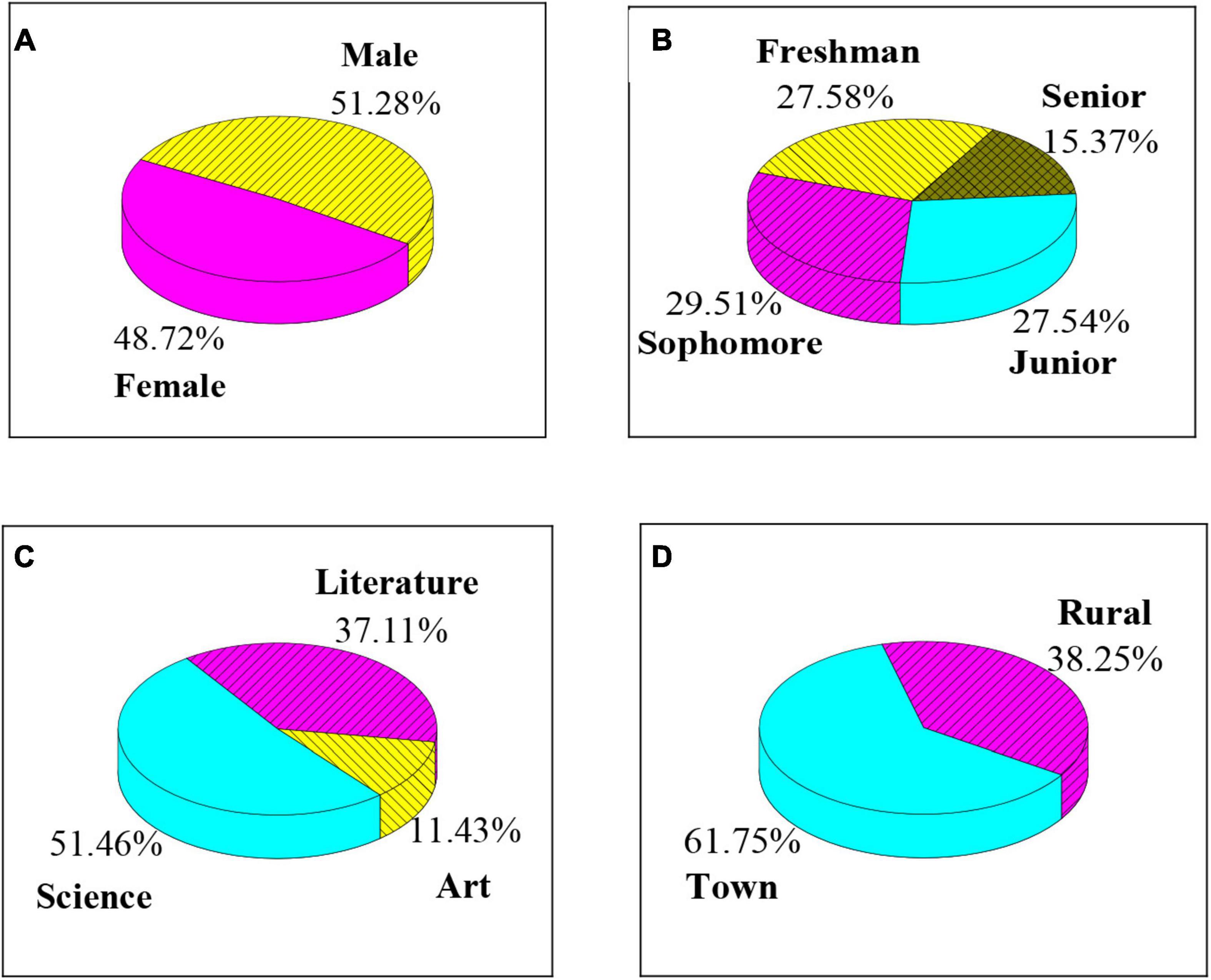
Figure 1. Comparison of basic information of selected college students. (A–D) Show the gender ratio, grade ratio, major type, and residence of college students, respectively.
Questionnaire Design
Physical Activity Questionnaire for College Students: it is compiled based on the International Physical Activity Questionnaire (IPAQ) from the perspective of educational psychology (Hajar et al., 2019) and the actual life state of college students in China. The questionnaire mainly includes four parts: the personal information of the subjects, the daily rest state, the mode of entertainment activities, and the amount of physical activity. Besides, the physical activity laws, characteristics, and methods of college students were designed. The questionnaire covered a total of 32 test questions.
Motor Function Assessment
The FMS system (Wang et al., 2017) based on the artificial intelligence and human–computer interaction, designed by American orthopedic expert Gray Cook and training expert Lee Burton in the 1990s, is adopted to test the motor function of selected college students. A four-level scoring system is used, with 0, 1, 2, and 3 points, respectively. Test 1 (over-squat squat): squat is used to detect the symmetry of the two sides of the body, the flexibility of the hips, knees, and ankles. The wooden pole above the head can detect the flexibility and symmetry of the shoulders and thoracic spine. Test 2 (hurdle step movement): hedge, knee, and ankle symmetry, flexibility, and stability can be detected through hurdle steps. Test 3 (linear lunge action): straight leg split squats can detect the flexibility of both sides of the body and the stability of the ankle and knee joints. Test 4 (shoulder flexibility movements): the shoulder flexibility test mainly reflects the abduction and rotation of the shoulder joint. Test 5 (active leg lift): the active leg lift test mainly reflects the active contraction ability of the hamstring muscle and the flexibility of the calf muscle when the pelvis was held in a fixed position. Test 6 (trunk stability push-ups): it mainly detects the stability of the trunk of the body in the sagittal plane when symmetrically using push-ups. Test 7 (body rotation stability): it mainly detects the stability and symmetry of the multi-dimensional surface of the trunk when the upper and lower limbs moved together.
Statistical Methods
The data processing of this study is analyzed by SPSS19.0 version statistical software. The measurement data are expressed as mean ± standard deviation ( s), and the count data are expressed as percentage (%). Spearman correlation and multivariate regression analysis (MRA) were used to analyze the correlation between motor function and physical activity status of college students (number of lunch breaks in a week, days of moderate exercise in a week, days of heavy activities in a week, class time in a day, sedentary time in a day, sleep time in a day, moderate exercise time of the day, heavy exercise time of the day, time of eye use within 1 day) and body mass index (BMI). P < 0.05 indicates that the difference was statistically significant. Origin8.0 is used to draw the figures.
Results
Physical Activity of College Students
As shown in Figure 2, the proportion of students with one to two lunch breaks in a week is 54.15%, followed by the proportion of students with zero lunch breaks (21.67%) and the proportion of students with three to four lunch breaks (15.72%); college students with 6–8 h sleep time account for the most (69.42%), followed by those with 8–12 h sleep time (18.61%).
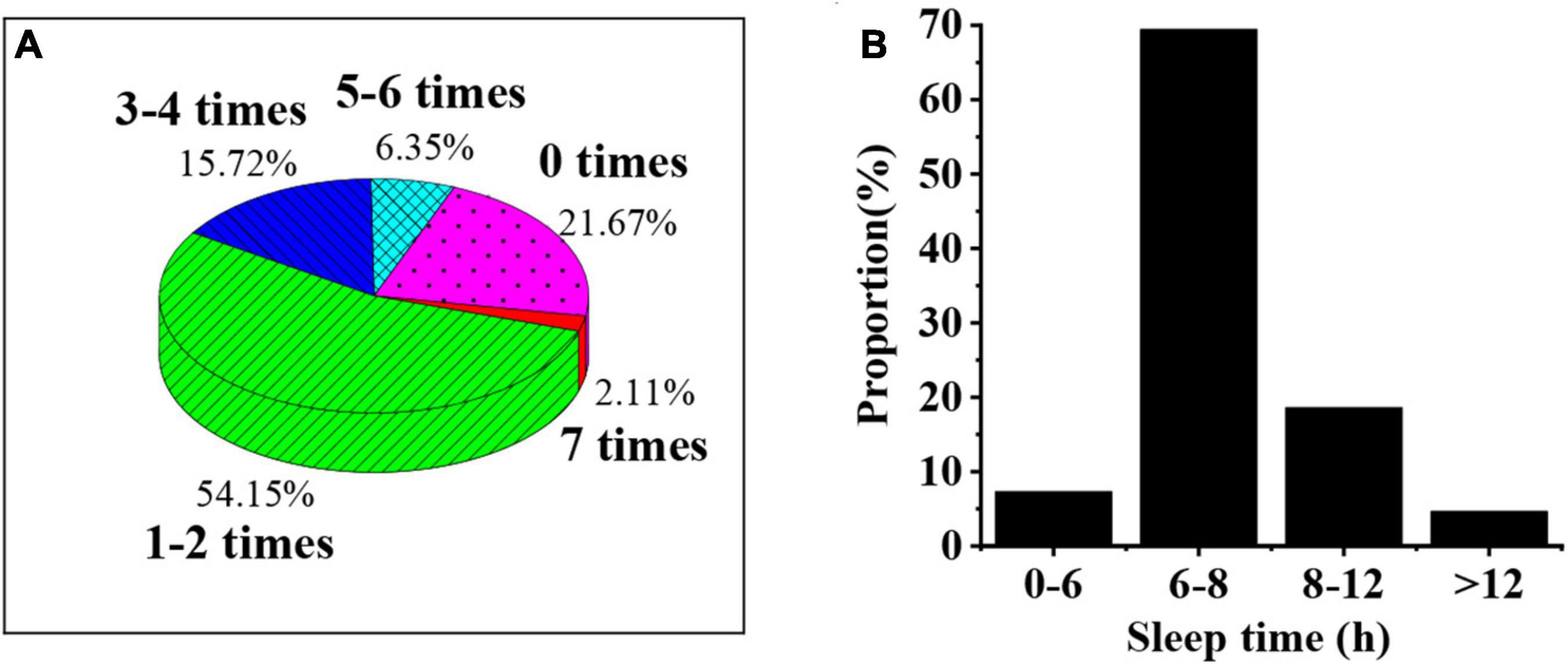
Figure 2. Overall rest of college students. (A) Was the number of lunch breaks a week for college students; (B) was the day’s sleep time for college students.
As shown in Figure 3, the proportion of students with 1–2 days moderate exercise in a week is the highest (50.61%), followed by those with 3–4 days (25.17%) and 7 days (4.79%) moderate exercise; students with an activity time of 10–20 min in a day account for the largest proportion (46.37%), followed by those with 20–30 min (26.72%), and the proportion of those with more than 30 min activity time is the smallest (13.60%).
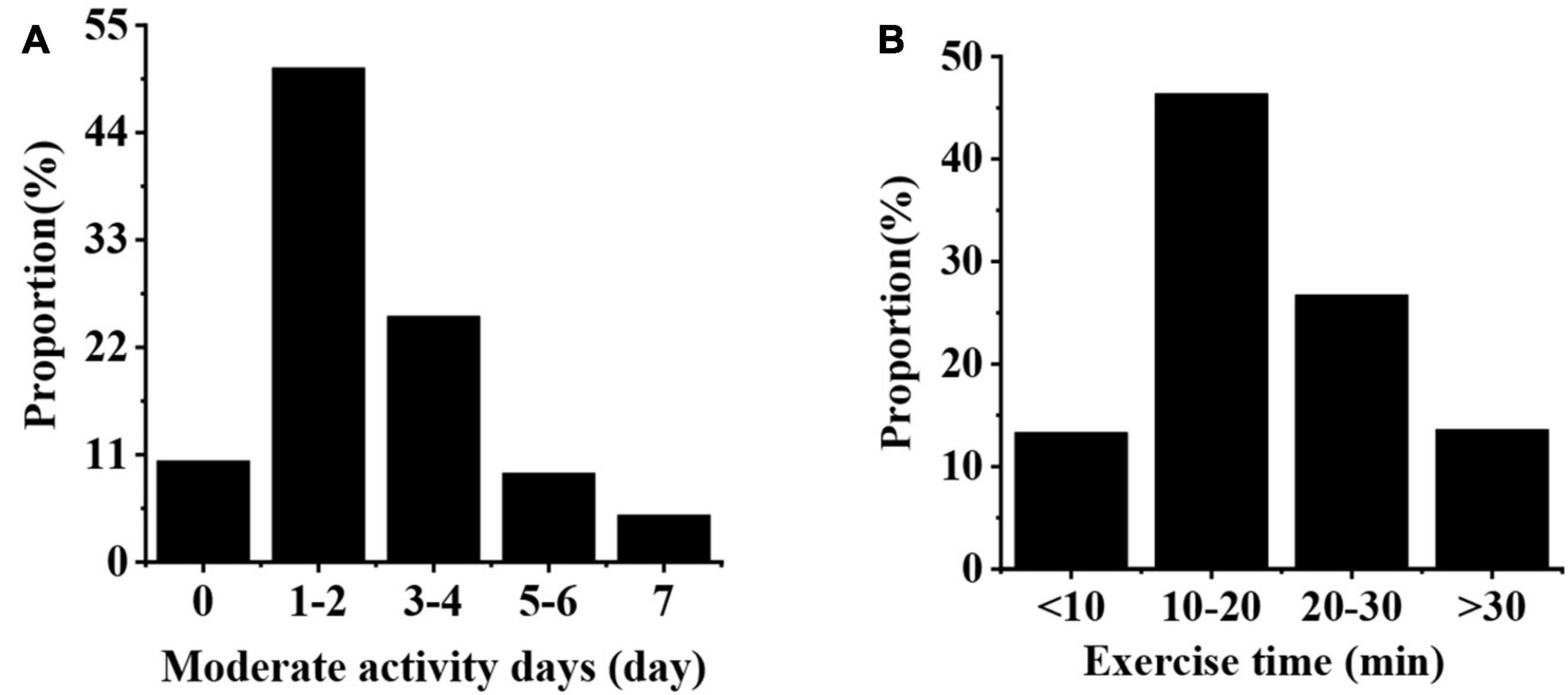
Figure 3. Moderate exercise status of college students. (A,B) Illustrate the number of moderate exercise days in a week and the moderate exercise time for college students in a day, respectively.
Physical Activities at the Learning Level
As shown in Figure 4, the proportion of students with 1–2 days heavy exercise in a week is the largest (47.26%), followed by the proportion of those with 3–4 days (19.42%) and the proportion of those with 7 days of activity (5.48%); the proportion of college students who spent 10–20 min on strong activities in a day is the highest (39.58%), followed by the proportion of those who spent 0 min (30.31%), and the proportion of those who spent more than 30 min is the least (5.91%).
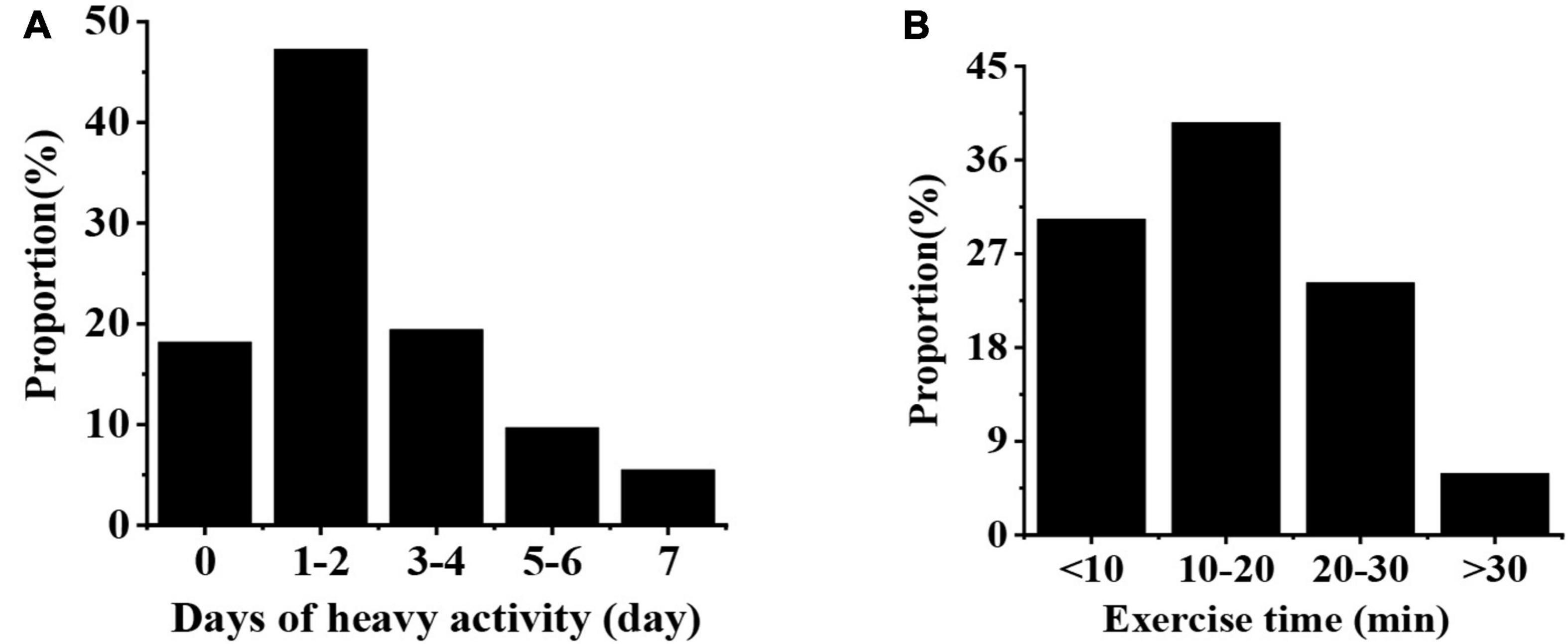
Figure 4. The status of heavy activities of college students. (A) Illustrates the number of days of heavy activities for college students, and (B) Indicates the day of heavy activities for college students.
As shown in Figure 5, college students with class hours of more than 5 h have the highest proportion (80.15%), and the proportion of those with class hours of less than 3 h is very small (2.06%); college students with more than 5 h of sedentary time have the highest proportion (40.61%), followed by the proportion of those with 4–5 h sedentary time (32.51%), and the proportion of those with class hours of less than 3 h is very small (10.41%); the proportion of college students with 8–10 h of eye use time in a day is the highest (43.61%), followed by the proportion of those with 5–8 h (24.66%) and 10–12 h (15.73%) of eye use time.
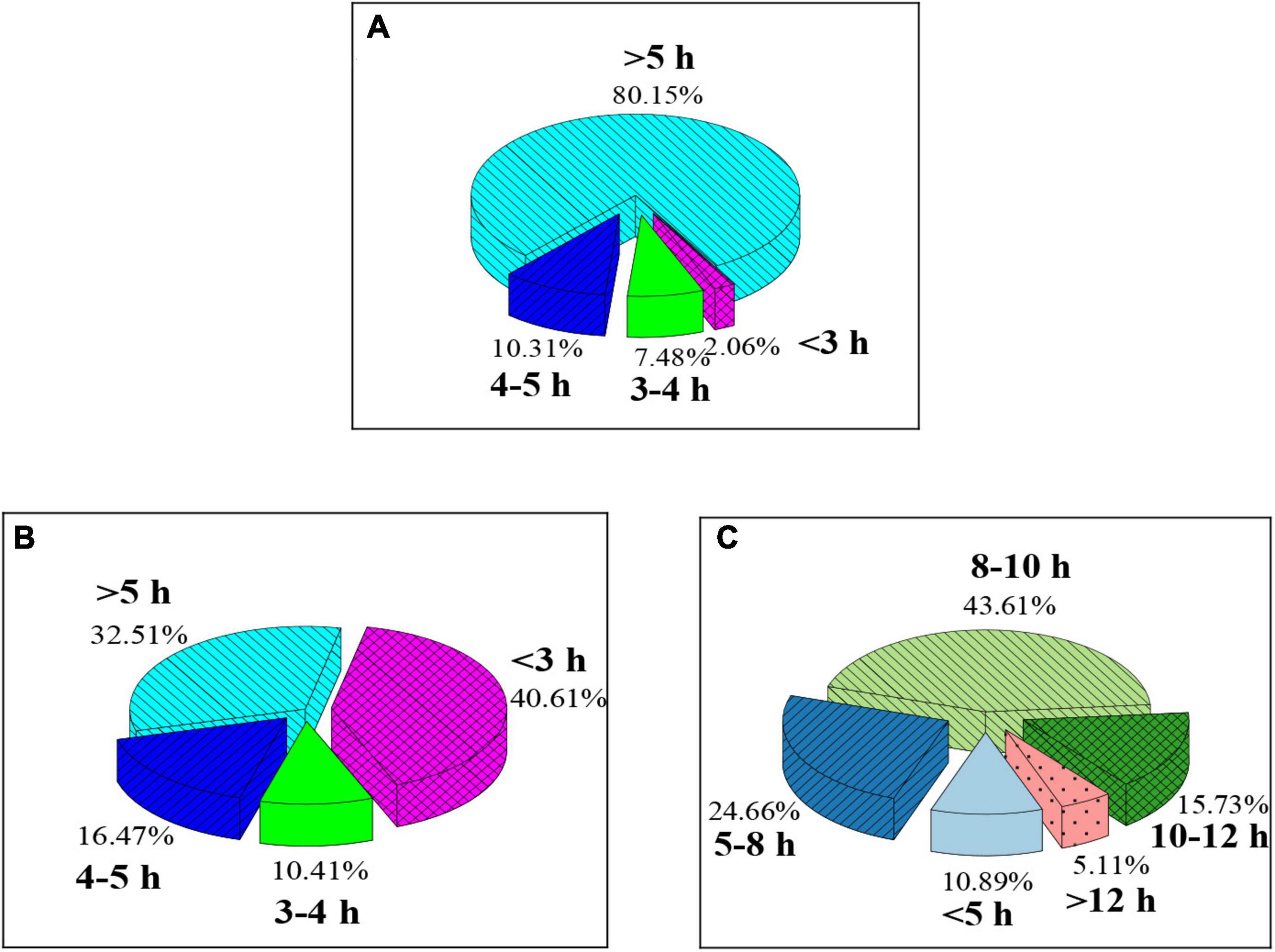
Figure 5. Physical activity of college students at the learning and entertainment level. (A–C) Indicate the class hours, sedentary time, and eye use time of college students in one day, respectively.
Motor Function Evaluation Results
As shown in Figure 6, the proportion of students with total FMS scores of 13–15 points is the highest (48.46%), followed by the proportion of those with less than 13 points (27.41%) and those with 16–18 points (15.94%), and the proportion of those with more than 18 points is the least (8.19%).
As shown in Figures 7, 8, among the college students’ FMS test items, test items scoring two points have the largest proportion among the seven. High squats (34.52%), straight lunges (39.03%), shoulder flexibility (33.88%), and torso flexibility (32.80%) have relatively high proportions among the three-point items; hurdles (21.03%), straight knee lift (22.52%), and body rotation stability (18.31%) have relatively low proportions among the three-point items.
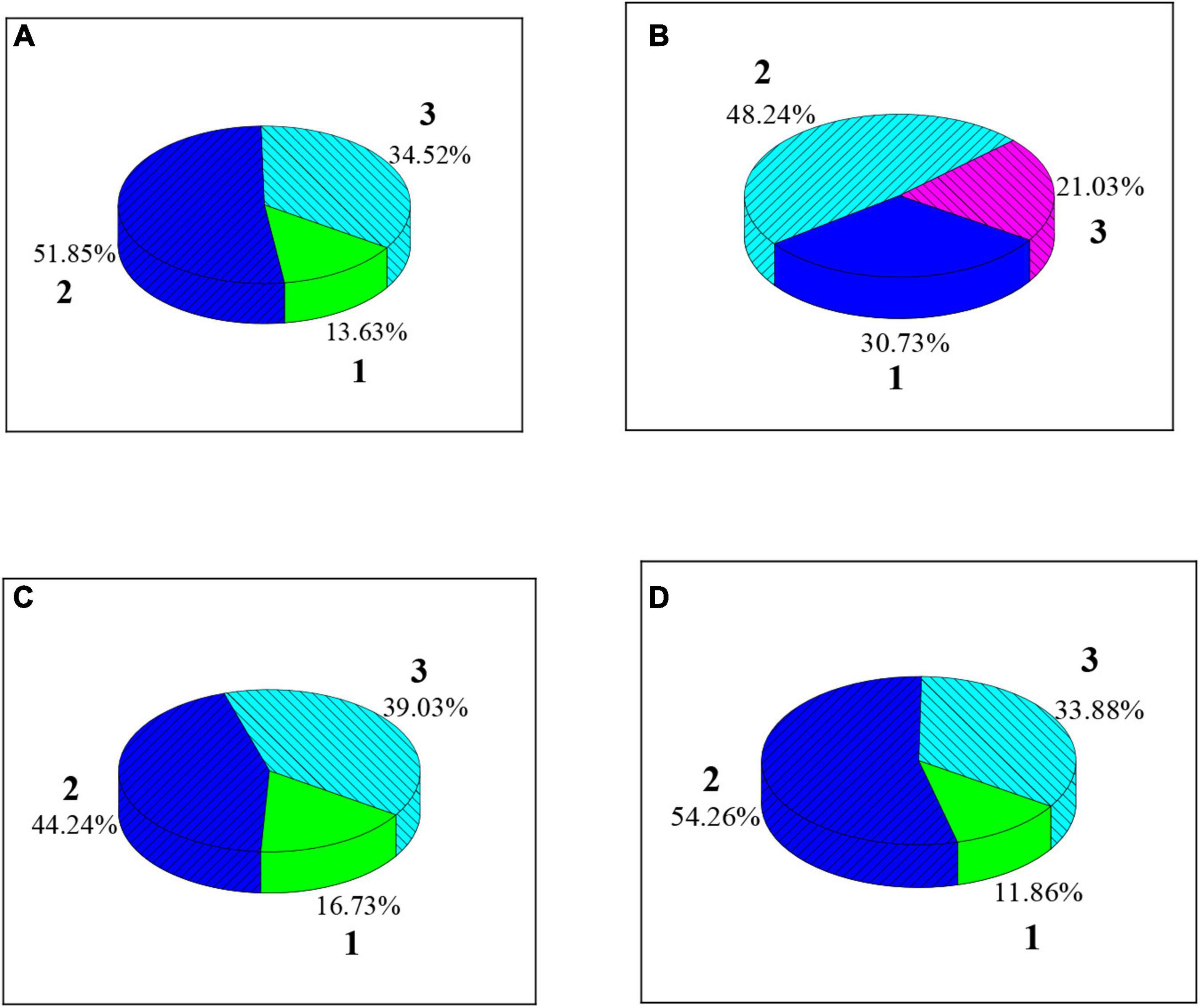
Figure 7. The proportion of different scores of the four test items of FMS for college students. (A) Was a squat over the top; (B) Was a hurdle; (C) Was a straight lunge; (D) Was shoulder flexibility.
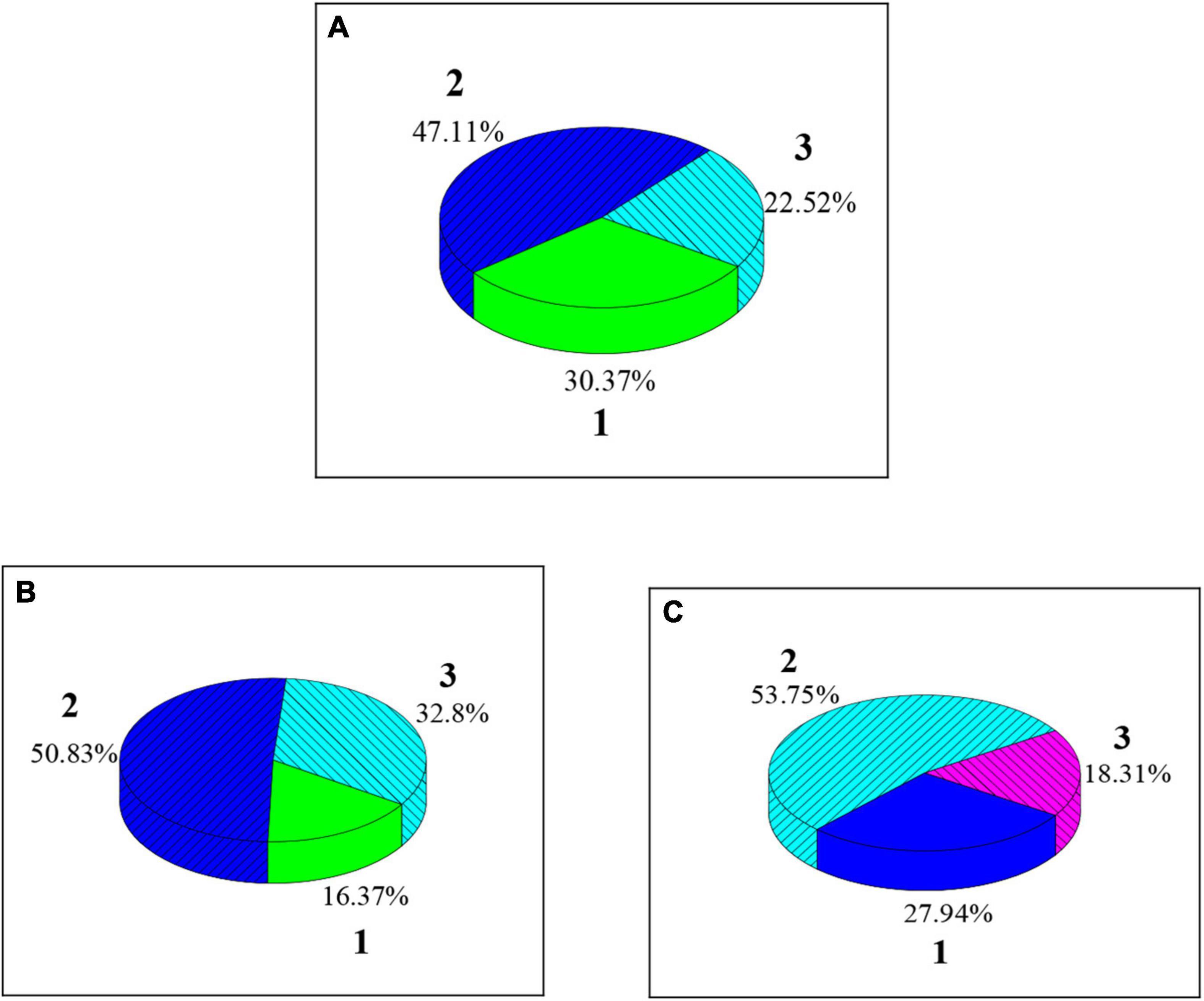
Figure 8. The proportion of different scores of the three test items of college students’ FMS. (A–C) Disclose the scores of straight knee lift, torso flexibility, and body rotation flexibility, respectively.
BMI of Selected College Students
As shown in Figure 9 below, the proportion of college students with a BMI of 18.5–24 kg/m2 is 69.32%, the proportion of those with more than 24 kg/m2 is 21.07%, and the proportion those with less than 18.5 kg/m2 is 9.61%.
Motor Function Scores in Demographic Variables
Table 1 suggests that there is no significant difference in college students’ FMS scores in terms of gender and place of residence (P > 0.05). FMS scores of college students have a significant difference in grades, and the FMS scores of junior students are significantly higher than those of students in other grades (P < 0.05). FMS scores of college students are significantly different in terms of majors, and the FMS scores of art students are significantly higher than those of students in other majors (P < 0.05).
Correlation Between BMI and Motor Function Score
As shown in Table 2, Spearman correlation analysis shows that there is a significant negative correlation between college students’ motor function score and BMI (r = -5.382, P < 0.05). MRA is conducted by taking BMI as an independent variable and motor function score as the dependent variable. As shown in Table 3, the regression coefficient of BMI and motor function score of college students was −0.488, which has a significant negative effect (P < 0.05).
Correlation of Physical Activity Level and Motor Function Score
Table 4 indicates that there is no significant correlation between college students’ motor function scores and the number of lunch breaks in a week, the number of moderate exercise days in a week, the number of heavy exercise days in a week, the class time in a day, and the sedentary time in a day (P > 0.05); college students’ motor function scores are significantly correlated with sleep time in a day, moderate exercise time in a day, heavy exercise time in a day, and eye use time in a day (P < 0.05).
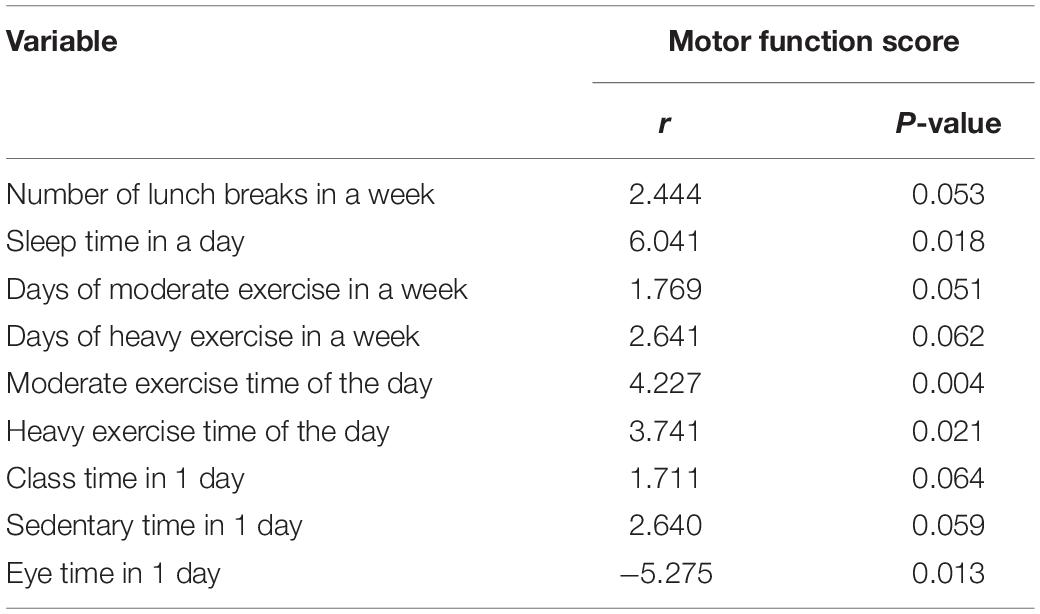
Table 4. Spearman correlation analysis of degree of physical activity and motor function score of college students.
As shown in Table 5, the regression coefficient of college students’ motor function score and sleep time within a day is 0.258, and there is no significant impact (P > 0.05); the regression coefficients of college students’ motor function score and 1-day moderate exercise time and heavy exercise time of one day are 0.531 and 0.527, respectively, and there are significant positive effects (P < 0.05); the regression coefficient of college students’ motor function score and eye use time within a day is −0.489, and there is a significant negative effect (P < 0.05).

Table 5. Multivariate regression analysis of the degree of physical activity and motor function score of college students.
Discussion
The development of students’ physical and psychological qualities during university is an important factor determining the direction of future life. The general static lifestyle has led to the decline of college students’ physical function, and it is a hot topic to use artificial intelligence and human–computer interaction technology to obtain body-related information (Zhang et al., 2019). Therefore, the Physical Activity Questionnaire for College Students is compiled by referring to the International Physical Activity Questionnaire. Students’ physical fitness is assessed based on FMS. It is found that college students with one to two lunch breaks in a week account for the largest proportion (54.15%), followed by the proportion of those with zero lunch breaks (21.67%) and the proportion of those with three to four lunch breaks (15.72%), which is similar to the survey results of Haidar et al. (2019). Rest is the basic condition for improving the body’s health index and completing daily activities. Good sleep can ensure the body’s athletic quality and mental health. However, the results show that many college students have a bad habit of not taking a lunch break during the day, which cannot reach the normal rest level. College students with 6–8 h sleep time in a day account for the most (69.42%), followed by 8–12 h (18.61%). From a psychological point of view, college students do not attach importance to the development of a sleep habit of 8 h a day and incline to sleep until they feel sleepy, which is different from the research results of Wilson O. W. A. et al. (2019).
Abundant amount of daily activities is conducive to improving the motor function of college students. It is found in the study that college students with 1–2 days moderate exercise have the largest proportion (50.61%); the proportion of students with activity time between 10 and 20 min is the highest (46.37%), which is different from the results of Liu et al. (2019). The reason may be that moderate activities generally refer to sports such as badminton, table tennis, and cycling, indicating that the college student group lacks additional moderate activities in addition to some daily activities. Therefore, it is necessary to strengthen the overall amount of moderate physical activity of college students (Win et al., 2019). College students with 1–2 days of strong activities account for the most (47.26%); the proportion of students with strong activities in 10–20 min is 39.58%, which is similar to the research results of Chan et al. (2019), indicating that the college student lack normal heavy exercise. As a result, the proportion of college students with moderate to strong physical activity is low. It is a problem that schools need to pay attention to. The proportion of college students with more than 5 h of class in a day is the highest (80.15%), and the proportion of those with less than 3 h is very small (2.06%). Because of the constraints of our education system, college students have to spend more time and energy completing schoolwork, which is also one of the factors that reduce physical activity of college students (Barkley et al., 2019). The students with eye use time of 8–10 h in a day have the highest proportion (43.61%), which is the same as the results of Ouyang et al. (2020). As entertainment activities such as computers, mobile phones, tablets, and games take up a lot of time for students, the eye use time is also prolonged greatly. Therefore, colleges should consider formulating strict physical activity programs to improve the psychological quality and athletic literacy of college students (Corder et al., 2019). The BMI can reflect the individual’s health status and the degree of fatness and thinness. It is found that the proportion of college students with a BMI of 18.5–24 is 69.32%, and the proportion of those with more than 24 is 21.07%, indicating that most of the students’ body weight was normal, but there are still more than 20% with obesity. Therefore, college students need to pay more attention to physical health and avoid obesity.
The proportion of students with a total FMS of 13–15 points is the highest (48.46%), followed by the proportion of those with less than 13 points (27.41%) and those with 16–18 points (15.94%), which is similar to the results of Lang et al. (2019). It indicates that most students’ overall motor function level is barely qualified, and a considerable number of people still suffer from low motor function. From the specific test items, squats (34.52%), straight lunges (39.03%), shoulder flexibility (33.88%), and torso flexibility (32.80%) account for a relatively high proportion among three-point items; hurdle steps (21.03%), straight knee lifts (22.52%), and body rotation stability (18.31%) account for a relatively low proportion among three-point items, which show that the overall ability of college students is better to complete over-the-top squats, straight lunge, and shoulder flexibility, but is poor to complete the hurdle step, straight knee lift, and body rotation stability test. The reason may be that the spine distortion caused by the students’ incorrect sitting posture for a long time affects their mental and physical health. The hurdle step, straight knee lift, and body rotation stability test can be added to the college physical education test to improve the student’s sports psychology quality (Chen, 2019; Saller and Khaled, 2019).
FMS scores of college students have significant differences in grades, and the FMS scores of junior students are significantly higher than those of other grades (P < 0.05), which is different from the results of Gong et al. (2019). It may be due to the academic pressure of freshman and sophomore students. The lack of sufficient after-school time results in poor average motor function, while the senior students face some pressures such as graduation, postgraduate examination, and employment, which lead to the reduction of daily physical activity, thus affecting the body’s motor function (Zeng et al., 2017). FMS scores of college students are significantly different in terms of majors, and the FMS scores of art students are significantly higher than those of students in other majors (P < 0.05), which is because art students have rich daily physical activities and more spare time, thus maintaining a high level of athletic ability (Suraya et al., 2017; Feng and Chen, 2020). MRA discloses that the regression coefficient of college students’ BMI and motor function score is −0.488, which has a significant negative effect (P < 0.05), indicating that the college student’s BMI is negatively correlated with their motor function level. Regression coefficients of college students’ motor function scores and moderate exercise time in a day and heavy exercise time in a day are 0.531 and 0.527, respectively, and there are significant positive effects (P < 0.05), showing that the activity of college students is positively correlated with the improvement of their motor function within a certain range. Thus, H7 and H8 are proved to be true. The regression coefficient of the motor function score of college students and the eye use time within a day is −0.489, which has a significant negative effect (P < 0.05), suggesting that the use frequency of computers and mobile phones can be shortened by reducing the eye use time, which is conducive to improving students’ psychological quality of sports. Thus, H9 is proved to be true (Fuertes and Hoffman, 2016). In addition, college students’ motor function scores are not significantly correlated to the number of lunch breaks in a week, the number of days of moderate exercise in a week, the number of days of heavy exercise in a week, the class hours in a day, the sedentary time in a day, and the sleep time in a day (P > 0.05), which indicates that the hypotheses H1, H2, H3, H4, H5, and H6 are not true.
Conclusion
The College Students Physical Activity Questionnaire is compiled by referring to the International Physical Activity Questionnaire, and the physical fitness of college students is assessed based on FMS. Sedentary habit is one of the basic factors leading to students’ low-level motor function, manifested by asymmetry of both sides of the body and poor trunk stability. It is recommended to add hurdles, straight knees, and body rotation stability tests to college physical education courses. However, the samples are selected from the same area, which may reduce the power of the study. An expanded sample size involving multiple areas in the future is necessary to strengthen the findings of the study. In conclusion, the study provides a theoretical basis for the improvement of college students’ mental health.
Data Availability Statement
The raw data supporting the conclusions of this article will be made available by the authors, without undue reservation.
Ethics Statement
The studies involving human participants were reviewed and approved by the Tianjin Normal University Ethics Committee. The patients/participants provided their written informed consent to participate in this study. Written informed consent was obtained from the individual(s) for the publication of any potentially identifiable images or data included in this article.
Author Contributions
All authors listed have made a substantial, direct and intellectual contribution to the work, and approved it for publication.
Funding
This work was supported by the Doctoral Fund Project of Tianjin Normal University (No. 043/135202WW1620).
Conflict of Interest
The authors declare that the research was conducted in the absence of any commercial or financial relationships that could be construed as a potential conflict of interest.
References
Acebes-Sánchez, J., Diez-Vega, I., Esteban-Gonzalo, S., and Rodriguez-Romo, G. (2019). Physical activity and emotional intelligence among undergraduate students: a correlational study. BMC Public Health 19:1241. doi: 10.1186/s12889-019-7576-5
Barkley, J. E., Glickman, E., Fennell, C., Kobak, M., Frank, M., and Farnell, G. (2019). The validity of the commercially-available, low-cost, wrist-worn Movband accelerometer during treadmill exercise and free-living physical activity. J Sport Sci. 37, 735–740. doi: 10.1080/02640414.2018.1523039
Brandwayn, N., Restrepo, D., Marcela Martinez-Martinez, A., and Acevedo-Triana, C. (2020). Effect of fine and gross motor training or motor imagery, delivered via novel or routine modes, on cognitive function. Appl. Neuropsychol. Adult 27, 450–467. doi: 10.1080/23279095.2019.1566133
Chan, J. S., Liu, G., Liang, D., Deng, K., Wu, J., and Yan, J. H. (2019). Special issue–therapeutic benefits of physical activity for mood: a systematic review on the effects of exercise intensity, duration, and modality. J. Psychol. 153, 102–125. doi: 10.1080/00223980.2018.1470487
Chen, M. (2019). The impact of expatriates’ cross-cultural adjustment on work stress and job involvement in the high-tech industry. Front. Psychol. 10:2228. doi: 10.3389/fpsyg.2019.02228
Corder, K., Winpenny, E., Love, R., Brown, H. E., White, M., and Sluijs, E. (2019). Change in physical activity from adolescence to early adulthood: a systematic review and meta-analysis of longitudinal cohort studies. Br. J. Sport Med. 53, 496–503. doi: 10.1136/bjsports-2016-097330
Feng, B., and Chen, M. (2020). The impact of entrepreneurial passion on psychology and behavior of entrepreneurs. Front. Psychol. 11:1733. doi: 10.3389/fpsyg.2020.01733
Fletcher, J. (2016). Applying self-determination theory to college students’ physical-activity behavior: Understanding the motivators for physical (in) activity. Commun. Stud. 67, 489–508. doi: 10.1080/10510974.2016.1212911
Fritz, A., Brandt, W., Gimpel, H., and Bayer, S. (2020). Moral agency without responsibility? analysis of three ethical models of human-computer interaction in times of artificial intelligence (AI). De Ethica 6, 3–22. doi: 10.3384/de-ethica.2001-8819.20613
Fuertes, J. N., and Hoffman, A. (2016). Alcohol consumption and abuse among college students: alarming rates among the best and the brightest. J. Coll. Stud. Dev. 50, 236–240.
Ghrouz, A. K., Noohu, M. M., Manzar, M. D., Spence, D. W., BaHammam, A. S., and Pandi-Perumal, S. R. (2019). Physical activity and sleep quality in relation to mental health among college students. Sleep Breath 23, 627–634. doi: 10.1007/s11325-019-01780-z
Goh, T. L., Webster, C. A., Brusseau, T. A., and Hannon, J. (2019). Infusing physical activity leadership training in PETE programs through university–school partnerships: principals’ and graduate students’. Exper. Phys. Educ. 76, 238–257. doi: 10.18666/TPE-2019-V76-I1-8725
Gong, J., Huang, Y., Chow, P. I., Fua, K., Gerber, M. S., Teachman, B. A., et al. (2019). Understanding behavioral dynamics of social anxiety among college students through smartphone sensors. Inform. Fusion 49, 57–68. doi: 10.1016/j.inffus.2018.09.002
Graupensperger, S., Wilson, O., Bopp, M., and Blair Evans, M. (2020). Longitudinal association between alcohol use and physical activity in US college students: evidence for directionality. J. Am. Coll. Health 68, 155–162. doi: 10.1080/07448481.2018.1536058
Haidar, A., Ranjit, N., Archer, N., and Hoelscher, D. M. (2019). Parental and peer social support is associated with healthier physical activity behaviors in adolescents: a cross-sectional analysis of texas school physical activity and nutrition (TX SPAN) data. BMC Public Health 19:640. doi: 10.1186/s12889-019-7001-0
Hajar, M. S., Rizal, H., Kueh, Y. C., Muhamad, A. S., and Kuan, G. (2019). The effects of brain breaks on motives of participation in physical activity among primary school children in Malaysia. Int. J. Environ. Res. 16:2331. doi: 10.3390/ijerph16132331
Holland, B., Needle, A. R., Battista, R. A., West, S. T., and Christiana, R. W. (2019). Physical activity levels among rural adolescents with a history of ankle sprain and chronic ankle instability. PloS One 14:e0216243. doi: 10.1371/journal.pone.0216243
Huberty, J., Green, J., Glissmann, C., Larkey, L., Puzia, M., and Lee, C. (2019). Efficacy of the mindfulness meditation mobile app “Calm” to reduce stress among college students: randomized controlled trial. JMIR Mhealth Uhealth 7:e14273. doi: 10.2196/14273
Kim, M. S., and Cardinal, B. J. (2019). Differences in college students’ motivation between a required and an elective physical activity education policy. J. Am. Coll. Health 67, 207–214. doi: 10.1080/07448481.2018.1469501
Klug, K. B., Kolobe, T. H. A., James, S. A., and Arnold, S. H. (2020). Concurrent validity of the school outcomes measure and the school function assessment in elementary students. Pediatr. Phys. Ther. 32, 180–188. doi: 10.1097/PEP.0000000000000710
Lang, C., Brand, S., Colledge, F., Ludyga, S., Pühse, U., and Gerber, M. (2019). Adolescents’ personal beliefs about sufficient physical activity are more closely related to sleep and psychological functioning than self-reported physical activity: a prospective study. J. Sport Health Sci. 8, 280–288. doi: 10.1016/j.jshs.2018.03.002
Lee, H. S., and Kim, E. J. (2015). The effect of the preparation and review times on the some items of the gross motor function measure evaluation capacity of the college students. J. Korean Phys. Soc. 10, 99–105. doi: 10.13066/kspm.2015.10.1.99
Liu, X., Gao, X., and Ping, S. (2019). Post-1990s college students academic sustainability: the role of negative emotions, achievement goals, and self-efficacy on academic performance. Sustain. Basel 11;775. doi: 10.3390/su11030775
Ouyang, Y., Wang, K., Zhang, T., Peng, L., Song, G., and Luo, J. (2020). The influence of sports participation on body image, self-efficacy, and self-esteem in college students. Front. Psychol. 10:3039. doi: 10.3389/fpsyg.2019.03039
Owens, H., Christian, B., and Polivka, B. (2017). Sleep behaviors in traditional-age college students: a state of the science review with implications for practice. J. Am. Assoc. Nurse Pract. 29, 695–703. doi: 10.1002/2327-6924.12520
Penglee, N., Christiana, R. W., Battista, R. A., and Rosenberg, E. (2019). Smartphone use and physical activity among college students in health science-related majors in the united states and thailand. Int. J. Environ. Res. 16:1315. doi: 10.3390/ijerph16081315
Robert, L. P. Jr., Bansal, G., and Luütge, C. (2020). ICIS 2019 SIGHCI workshop panel report: human–computer interaction challenges and opportunities for fair, trustworthy and ethical artificial intelligence. AIS Transac. Hum. Comp. Interac. 12, 96–108. doi: 10.17705/1thci.00130
Saller, F. V., and Khaled, S. M. (2019). Potential psychosocial influences on gender differences in physical activity among qatari adolescents: a first insight through descriptive observation. Int. J. Adolesc. Youth 24, 234–251. doi: 10.1080/02673843.2018.1515087
Suraya, F., Meo, S. A., Almubarak, Z., and Alqaseem, Y. A. (2017). Effect of obesity on academic grades among saudi female medical students at college of medicine, king saud university: pilot study. J. Pak. Med. Assoc. 67, 1266–1269.
Wang, Y. G., Chen, S., Xu, Z. M., Shen, Z. H., Wang, Y. Q., He, X. Y., et al. (2017). Family history of suicide and high motor impulsivity distinguish suicide attempters from suicide ideators among college students. J. Psychiatr. Res. 90, 21–25. doi: 10.1016/j.jpsychires.2017.02.006
Wilson, O. W., Bopp, C. M., Papalia, Z., and Bopp, M. (2019). Objective vs self-report assessment of height, weight and body mass index: relationships with adiposity, aerobic fitness and physical activity. Obes. Res. Clin. Pract. 9:e12331. doi: 10.1111/cob.12331
Wilson, O. W. A., Papalia, Z., Duffey, M., and Bopp, M. (2019). Differences in college students’ aerobic physical activity and muscle-strengthening activities based on gender, race, and sexual orientation. Preven. Med. Rep. 16:100984. doi: 10.1016/j.pmedr.2019.100984
Win, K. T., Roberts, M. R., and Oinas-Kukkonen, H. (2019). Persuasive system features in computer-mediated lifestyle modification interventions for physical activity. Inform. Health Soc. CA 44, 376–404. doi: 10.1080/17538157.2018.1511565
Yıldız, T. (2019). Human-computer interaction problem in learning: could the key be hidden somewhere between social interaction and development of tools? Integr. Psychol. Behav. 53, 541–557. doi: 10.1007/s12124-019-09484-5
Zeng, N., Pope, Z., and Gao, Z. (2017). Acute effect of virtual reality exercise bike games on college students’ physiological and psychological outcomes. Cyberpsych. Beh. Soc. N. 20, 453–457. doi: 10.1089/cyber.2017.0042
Zhang, N., Du, S. M., Zhang, J. F., and Ma, G. S. (2019). Effects of dehydration and rehydration on cognitive performance and mood among male college students in cangzhou, china: a self-controlled trial. Int. J. Environ. Res. 16:1891. doi: 10.3390/ijerph16111891
Keywords: educational psychology, static lifestyle, physical activity status, body motor function, college students, questionnaire survey
Citation: Ge S, Song C and Yao W (2021) The Motor Function Evaluation of College Students’ Physical Activity State From the Perspective of Educational Psychology. Front. Psychol. 12:593285. doi: 10.3389/fpsyg.2021.593285
Received: 10 August 2020; Accepted: 02 February 2021;
Published: 15 April 2021.
Edited by:
Yenchun Jim Wu, National Taiwan Normal University, TaiwanReviewed by:
Hedy Hamilton, Red Rocks Community College, United StatesCecilia Liang, Wonkwang University, South Korea
Copyright © 2021 Ge, Song and Yao. This is an open-access article distributed under the terms of the Creative Commons Attribution License (CC BY). The use, distribution or reproduction in other forums is permitted, provided the original author(s) and the copyright owner(s) are credited and that the original publication in this journal is cited, in accordance with accepted academic practice. No use, distribution or reproduction is permitted which does not comply with these terms.
*Correspondence: Chao Song, Y3NvbmdAdGpudS5lZHUuY24=
 Sha Ge
Sha Ge Chao Song
Chao Song Wanxiang Yao
Wanxiang Yao